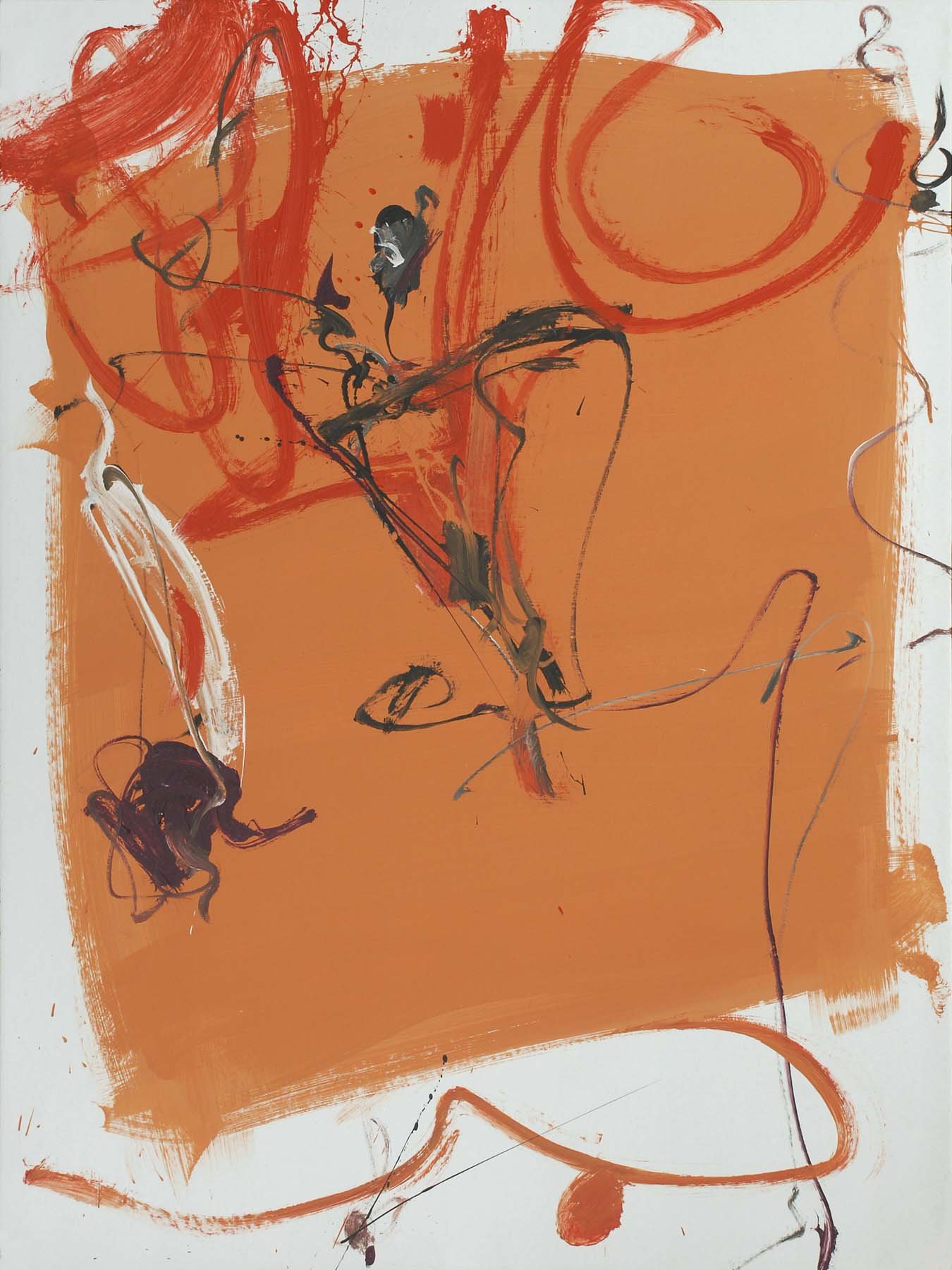
If You Look You May Not Leap - Susmit Biswas
June, 2008
For Susmit Biswas, restraint is futile. He continuously stretches the parameters of the creative agenda he sets for himself and flirts as much with accident as he does with beautifully cadenced acts of control.
Standing a few feet away from his pictures, one gets the slightly dizzy feeling of looking up into the sky. They do not resemble constellations but provide a sense of the infinite. His art, contrary to popular belief, is focused and centred upon rhythm and compels the viewer to take in the entire image from a distance while, at the same time, wanting to nose up to admire its details. These are the works of a very fine painter and the way the viewer moves back and forth before an image reiterates the ballet he performs both within the piece and in the physical act of painting.
Biswas is radical and audacious. Sometimes he creates visual sonatas of the Mozartian kind and at others brings to mind the opening moments of an alaap in, say, Bhairavi. He breaks and recreates rules but is consistently and astonishingly beautiful. Now a determined colourist with a truly ecstatic and exuberant palette, he displays a panorama of greens, purples, blues and reds which makes the swarm of whirling lines and shapes come to life, shimmer with energy and radiate light and warmth. While very vibrant, the palette is never garish or vulgar. Neither, though, is it prissy. Elegant, refined and vivacious, it is all about self-generated energy.
Biswas splashes, slathers, flicks, pours, scrawls, smudges and applies paint with a brush on to his surfaces. The paint is carefully, almost studiously, put down. It looks serendipitous but is done painstakingly and worked and reworked till the artist is satisfied with the result. His gestures – whirls, swirls and commas to name but a few – are akin to signatures and derive partly from a fine sense of draughtsmanship although it is folly to try to attribute specific meanings to them. Some are chimeras, ghosts within the image which seduce and entice the viewer. There is, however, no repetition in these works. Instead, there is great diversity in form, gesture, tempo, cadence and colour.
The influences are myriad from tribal art, to graphic novels to looping calligraphy, but are never overwhelming or derivative. Delicate, spun-sugar lines float against surfaces, bleed at their edges and almost evaporate while thicker, more robust, lines explode with passion. Fundamentally, these are essays in freedom and rhythm. Biswas never struggles with his draughtsmanship. It is an integral element in his visual brocade woven from threads of dripped, splashed and drizzled colour. Its distinctive linear style is refreshingly free from academic encumbrances.
One can formulate several dialectics in a Susmit Biswas painting. There is expansiveness as well as a sense of containment; fiery introspection as well as a cool and clear-eyed observation of the world around him. Some of the works are so vivid that they appear to be alive, lines dancing on the pictorial surface, leading the eye into mysterious and wonderful places. The paintings are less about conflicts and more about resolutions within the paradigms of figures, abstraction and colour.
Biswas’s visual cadences are heroic, weaving a web around the viewer, holding them within the painting in an almost sexual embrace. They retain their conviction throughout. Very rarely do the lines slacken or the trajectories of movement turn into mere decorative threads. He is fast moving towards mastering his technique and a comparison with his early works clearly illustrates this journey. Multiple skilful variations on not just line but also colour and drip have begun to yield pictures which transcend the conventionally beautiful and are uncannily pleasing to the eye. They are freer, more animated and more immediate than the earlier works and also demonstrate a greater sense of balance and symmetry.
One feels a thirst for Biswas’s art and is fascinated by its unconventional aesthetics and extreme grace. Here is an artist who works on his art: constantly tinkering with new ways to make it but figuring out exactly what he wants to achieve. Nothing looks fidgety or tentative. He knows enough about his discoveries and innovations to bring them to resolution. Sometimes this innovation is merely a matter of altered perspective, of changed position or material. Threads of alchemically mixed paint spinning across canvas and paper leaving comet tails in their wake is just one of the many extraordinary facets of a Biswas image. He does just the right number of things in extraordinary ways to make his art both stimulating and intriguing. He thickens and thins texture, flattens his surface, controls velocity, hints at imagery or stays abstract. No two paintings in this show are the same, and what is most fascinating is that they are different in varying ways; something one realizes only when one sees all the works together.
Biswas is a virtuoso who has customized the notion of virtuosity. He has transformed the act of making pictures into a frenetic dance, the pictorial surface into a place of enchantment and the use of colour into pure alchemy. One can feel his body in the works, in their lightness, rapidity, responsiveness and beats. These paintings, however, are not self-revelatory or programmatic in any fashion. They are presences, surfaces reflecting the ideas and desires projected upon them. They could range in interpretation from revolutionary to assertive to fraught to masculine. So be it.
For Biswas, colour is a drug that gives the most satisfying, transforming, transcendental and hallucinatory of experiences. It is the energy of his line, though, with its grimaces now unravelled and its kinks smoothed out which is most gratifying. Some of the lines are surprisingly airy and light. Akin to calligraphic jots, they are starts and turns of the brush with added highlights like diacritical marks and softer hues.
Sublimely lyrical, these images are born of continual and continuous experimentation. The fluid, colourful synthesis of elements makes Biswas’s oeuvre appear seemingly abstract but it is, in fact, endlessly suggestive. This is especially true of the smaller works in which the viewer is rewarded with an expanded sense of seeing. The distance between the fine detailing of the works – the individual strands and webs of colour as well as their skein like totalities – is distinctly and decisively shortened. The eye takes in the parts and the whole simultaneously which is not always possible with the larger works. There is something enigmatically thrilling when these two levels of perception collide allowing one to roam effortlessly over every bit of the surface, losing oneself in the labyrinthine intricacies of the precise dripped lines and then draw back for the long view, all without moving an inch.
The variation in the sizes of the works also makes comparisons easier which emphasizes the range of Biswas’s technique and also his naturalness. The variety of cadences, rhythms, marks, densities and compositional strategies underscores the notion that for this artist, technique is largely about difference and mastering difference to the point of perfection.
Biswas compresses structure, space, light and emotion into a few instantaneous gestures which gives his art its lyrical, transporting economy. His achievement is as much about finding these gestures as varying them. Languidly extended and looped lines, sometimes gently coiled and recoiled build up into entrancing compositions. Individual shifts in rhythm, gesture, colour and texture orchestrate the final image. The matrix of fine lines with its thick swirling arabesques is truly tantalizing. Through self-inquiry and experimentation, Susmit has achieved a unique pictorial imagery which is complex and sophisticated, but not obscure. This is meditative art full of energy and rhythm, every piece something of a surprise. Refreshing and inspired, it is all about the nuanced interaction between the mind, the eye and the brush. These are records of a singular sensitivity, an inner vision compellingly reflected on canvas and paper.
Anirudh Chari




























